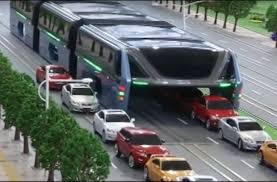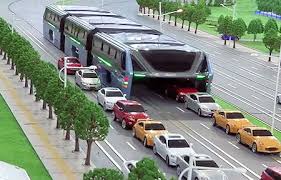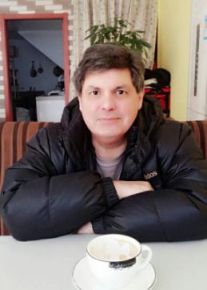There are 20 million new cars being added to China’s roadways each year. Those new cars are also adding to China’s mounting traffic congestion and not to mention the ever growing problems of air pollution. I too have witnessed growing traffic jams and air pollution in China, especially, in the city of Suzhou where I live and work.
Many local governments in China are hoping that parking regulations and plate restrictions will ease the traffic congestion, while engineers and designers are trying to find relief in technology. Engineers in Beijing believe they have come up with a solution in relieving some of the traffic congestion.
They call their solution the
“straddling bus” which has the capability to glide above the city
traffic.

|
Participants at the 19th International High-Tech Expo in Beijing (in May of this year) watched excitedly as a tiny “straddling bus” glided above the traffic in a model city. It’s a replica of what could be the future of China’s public transportation.
The bus will be able to carry 1,400 passengers above the city traffic at a speed of approximately 40 miles per hour. The bus would span two traffic lanes on a special track, allowing regular cars under 7 feet high to freely pass underneath.
What captured the interest of the City of Beijing is that the “straddling bus” would run on electricity and take the place of 40 buses, which could cut annual fuel consumption by 800 tons and carbon emissions by almost 2,500 tons. It would also be less expensive than a subway system because it would not involve digging up the ground.
The concept of a “Straddling Bus” is not new, a similar proposal, was offered to cut down traffic congestion in New York City back in 1969. Two architects—Craig Hodgetts and Lester Walker called their 1969 dream proposal the Bos-Wash Land-liner, as it would run between Washington, D.C., and Boston. They envisioned the Bos-Wash Land-liner - bound for Boston - to streak through the 86th street reservoir area of Central Park dropping off and picking up busloads of commuters before it resumes full speed of 200 miles an hour. They also envisioned their land-liner to ride on nearly friction-free air cushion bearings with fan-jets having a re-generator cycle. That means no hot exhaust—important since the Land-liner will be zooming only 16 feet over your head if you are driving along the freeway.

|
The concept of the “straddling bus” grabbed international headlines in May of this year.
The Beijing-based company Transit Explore Bus is currently building
a life-size model in Changzhou and they plan to test it in July or August.
China’s government is hoping that the “straddling bus” will ease their transit problems but the Chinese government is fully aware that it will take years for the country to bring down its pollution levels.

|
China will have to develop new technologies that go far beyond the “straddling bus”
in order to reduce its pollution.
They also need to find ways to encourage China’s 1.4 billion people to change their behaviors and attitudes by becoming more environmentally friendly. Pollution and traffic congestion are truly problematic in China and the “straddling bus” seems to be a small step in the right direction.
- Always with love from Suzhou, China
Thomas F O’Neill
- WeChat - Thomas_F_ONeill
- U.S. voice mail: (800) 272-6464
- China Cell: 011-86-15114565945
- Skype: thomas_f_oneill
- Email: introspective7@hotmail.com
- Other articles, short stories, and commentaries by Thomas F. O'Neill can be found on his award winning blog, Link:
http://thomasfoneill.blogspot.com






No comments:
Post a Comment